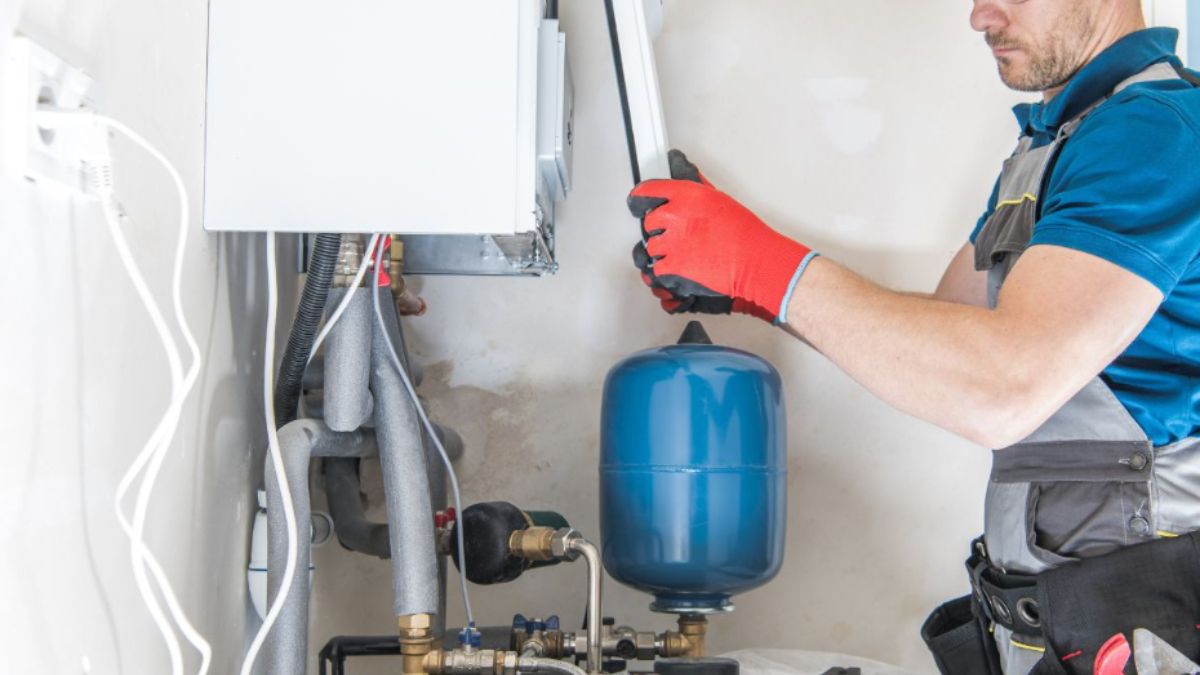TOPIC
You Might Need to Replace Your Water Heater

Replacing your water heater might sound like a big, intimidating task, but with the right knowledge and a solid plan, it can be a smooth and rewarding experience. Whether you’re replacing an old tank water heater or upgrading to a modern tankless system, this water heater replacement guide will equip you with all the essential information. From understanding the different types of water heaters to navigating the installation process, this guide will make sure you’re prepared for every step—whether you decide to tackle the project yourself or bring in a professional plumber. Let’s dive in and make this essential home improvement both easy and efficient!
Why You Might Need to Replace Your Water Heater
Before diving into the replacement process, it’s important to understand why your water heater might need replacement. Common reasons include:
- Age: Traditional water heaters typically last 10-15 years. If yours is nearing or exceeding this age, it’s probably time for a replacement.
- Leaks: Water pooling around the base of the heater often signals a leak that cannot be repaired.
- Rust or Sediment Buildup: If your water heater produces rusty or discolored water, it’s a sign of internal corrosion or sediment buildup.
- Inefficiency: If your unit is no longer providing sufficient hot water or is using more energy than usual, a replacement may be necessary.
Step 1: Choose Your New Water Heater
The first step in replacing a water heater is deciding which type to install. You can choose between a traditional tank water heater or a more modern tankless option.
- Tank Water Heater: These are the most common type of water heater. They store hot water in a tank and supply it as needed.
- Tankless Water Heater: This type heats water on demand, providing an endless hot water supply while saving space and energy. It’s ideal for smaller homes or those with high water usage needs.
Once you’ve decided which system works best for your needs, make sure to select a unit with the correct capacity. A water heater that’s too small won’t meet your needs, while a unit that’s too large may waste energy.
Step 2: Turn Off the Power and Water Supply
Before you start the replacement process, ensure safety by turning off the power supply to the water heater. If you have an electric water heater, switch off the breaker at your electrical panel. For gas water heaters, turn off the gas supply valve.
Next, turn off the water supply to the heater by closing the shutoff valve, which is usually located near the top of the tank. It’s important to release any pressure in the system before proceeding.
Step 3: Drain the Water Heater
Draining your old water heater is crucial to avoid spills and to prepare the unit for removal. Connect a garden hose to the drain valve at the bottom of the tank, and direct it to a nearby floor drain or outside. Open the valve and allow the tank to empty completely. You may need to open the pressure relief valve to help the water drain more easily.
Step 4: Disconnect the Old Water Heater
Once the tank is drained, disconnect the water heater from the plumbing and electrical connections. For electric units, disconnect the wiring by removing the access panel at the top of the unit. For gas units, disconnect the gas line using a wrench. Always check for any gas leaks before proceeding.
After the connections are safely disconnected, you can remove the old water heater from its position. This step may require some assistance, as water heaters can be heavy.
Step 5: Prepare the Space for the New Water Heater
Before installing the new unit, take a moment to inspect the area where the old heater was located. Ensure the space is clear of debris and that all connections are accessible. If you are switching from a tank water heater to a tankless system, you may need to make adjustments to the plumbing, ventilation, or electrical setup.
Step 6: Install the New Water Heater
- For Tank Water Heaters: Start by positioning the new unit in place. Connect the cold water supply pipe to the inlet and the hot water pipe to the outlet on the top of the tank. Tighten all fittings securely to prevent leaks. Once the plumbing connections are complete, connect the electrical or gas supply.
- For Tankless Water Heaters: Install the tankless unit according to the manufacturer’s instructions. These units often require a larger gas line or a dedicated electrical circuit. Make sure to install the necessary venting system for proper exhaust.
Step 7: Test the New Water Heater
Once your new water heater is installed, it’s time to test the system. Turn on the water supply and check for leaks around all connections. For electric models, turn the power back on, and for gas models, open the gas valve and relight the pilot light if needed. Set the thermostat to your desired temperature and allow the system to fill with water.
It may take some time for the unit to heat up the water fully, so be patient. Once the water reaches the set temperature, check the system again for proper functionality and make sure there are no leaks.
Step 8: Clean Up and Dispose of the Old Heater
Once you’ve confirmed that the new unit is working properly, clean up the installation site and dispose of the old water heater. Contact a local recycling center to ensure that the unit is disposed of properly.
DIY Water Heater Replacement vs. Professional Installation
While DIY water heater replacement is an option for some homeowners, there are a few things to keep in mind before proceeding with the replacement yourself:
- Skills and Tools: Installing a new water heater requires specialized knowledge, tools, and experience. Incorrect installation can result in leaks, water damage, or unsafe conditions.
- Local Codes and Permits: Depending on your area, you may need a permit for the installation. Be sure to check with local authorities.
- Safety: Gas lines and electrical systems require specialized training to handle safely.
If you are unsure or uncomfortable with any part of the installation process, hiring a professional plumber is always a safe option.
Replacing a water heater is a manageable project for homeowners who are comfortable with DIY tasks, but it requires attention to detail and strict adherence to safety procedures. Whether you are replacing an old water heater with a more energy-efficient model or switching to a tankless unit, following this step-by-step guide will help you achieve a successful installation. If you’re ever in doubt, don’t hesitate to reach out to a professional plumber to ensure the job is done correctly.
Recommended SEO Title: Step-by-Step Guide to Replacing Your Water Heater: A Complete DIY and Professional Installation Guide
Recommended Meta Description: Discover how to replace your water heater with this detailed step-by-step guide. Whether you’re installing a tank or tankless system, get expert tips for success.
Recommended Featured Snippet: Replacing a water heater involves turning off the power and water supply, draining the tank, disconnecting old plumbing, and installing the new unit. Always test the system before disposing of the old water heater.
Recommended H1 Tag:
Step-by-Step Guide to Replacing Your Water Heater
TOPIC
How to Treat Choking and Bleeding in Your Dog or Cat

Introduction
Dogs and cats can get into trouble quickly, whether by swallowing small objects, injuring themselves, or having an accident at home. Choking and bleeding are common emergencies that can become life-threatening if not handled immediately. Knowing how to respond quickly with proper first aid skills can save your pet’s life. Training in pet CPR and first aid gives owners the confidence and knowledge to act effectively in these stressful situations.
Recognizing Choking in Pets
Choking occurs when an object blocks a pet’s airway, preventing them from breathing properly. Signs of choking include:
- Gagging or retching
- Pawing at the mouth
- Difficulty breathing or noisy breathing
- Blue or pale gums
- Collapse or unconsciousness in severe cases
Identifying these symptoms quickly allows for immediate intervention before serious harm occurs.
Steps to Treat a Choking Pet
If your dog or cat is choking, follow these steps carefully:
- Stay calm: Your pet will sense panic, which can make the situation worse.
- Check the mouth: Look for visible objects, but do not push it further down.
- Remove the obstruction: Use your fingers or tweezers carefully if visible and reachable.
- Back blows or abdominal thrusts: For small pets, gentle back blows may help dislodge the object. For larger dogs, abdominal thrusts can be applied.
- CPR if necessary: If your pet becomes unresponsive or stops breathing, begin pet CPR if trained.
Knowing these steps and practicing them beforehand increases the chance of a positive outcome.
Recognizing Bleeding Emergencies
Bleeding in pets can happen from cuts, scrapes, bites, or accidents. Signs that bleeding needs immediate attention include:
- Blood soaking through bandages quickly
- Spurting blood from a wound
- Pale gums or signs of shock
- Weakness or lethargy
Prompt first aid can reduce blood loss and prevent further complications.
Steps to Stop Bleeding
When your pet is bleeding, follow these first aid steps:
- Apply direct pressure: Use a clean cloth or gauze on the wound.
- Elevate the injured area: If possible, raise the limb above heart level.
- Use a bandage or dressing: Secure gently without cutting off circulation.
- Monitor your pet: Watch for signs of shock or weakness.
- Seek veterinary care: Even if bleeding stops, professional evaluation is recommended.
Quick and calm intervention can significantly reduce the severity of bleeding injuries.
The Importance of Pet CPR and First Aid Certification
Certification provides pet owners with the knowledge and confidence to handle emergencies effectively. Benefits include:
- Hands-on training: Learn techniques like chest compressions and rescue breaths for pets
- Structured guidance: Step-by-step instruction ensures you act correctly
- Preparedness for emergencies: Be ready for choking, bleeding, or cardiac events
- Confidence: Stay calm and act quickly during high-stress situations
- Coverage for all pets: Training usually includes dogs, cats, and small animals
Certification equips owners with life-saving skills that go beyond basic knowledge.
Additional First Aid Skills for Pet Emergencies
Beyond choking and bleeding, pet first aid training covers:
- Wound care: Cleaning and dressing minor injuries
- Burn management: Cooling and protecting affected areas
- Fracture stabilization: Supporting broken or injured limbs
- Poison response: Recognizing symptoms and seeking veterinary guidance
- Shock management: Keeping pets warm, calm, and stable
A well-rounded skill set ensures you can handle a variety of emergencies confidently.
Why Online Training Works
Many pet CPR and first aid programs are available online, offering flexibility and accessibility:
- Self-paced learning: Complete lessons at your convenience
- Interactive content: Videos, quizzes, and simulations reinforce skills
- Immediate certification: Receive proof of completion quickly
- Accessible anywhere: Learn from home, work, or while traveling
Online programs allow busy pet owners to gain critical skills efficiently.
Maintaining Skills After Certification
Even after training, practicing first aid regularly is crucial:
- Refresher exercises: Practice techniques periodically
- Review course materials: Refresh your memory on emergency procedures
- Stay updated: Follow new guidelines or recommendations from veterinarians
- Teach family members: Sharing skills ensures everyone is prepared
Consistent practice ensures readiness when emergencies occur.
Common Misconceptions About Pet First Aid
- Myth: Only veterinarians need CPR and first aid skills.
Fact: Trained owners can save lives before professional help arrives. - Myth: Pet first aid is too difficult to learn.
Fact: Structured courses break down steps in a simple, practical way. - Myth: Small pets don’t require emergency care.
Fact: All pets, regardless of size, can benefit from immediate and proper intervention.
Understanding the truth encourages prompt and effective action.
Conclusion
Choking and bleeding are serious emergencies for dogs and cats. Knowing how to respond quickly can save lives and reduce suffering. Training in pet CPR and first aid provides essential skills, confidence, and hands-on experience to handle these situations effectively. Certification ensures that owners are ready to act calmly and correctly when their pets need help the most.
For a reliable and convenient option, consider enrolling in https://cprcertificationnow.com/products/pet-cpr-first-aid-certification today. Gain the knowledge and skills to act quickly, providing your pets with the best chance during emergencies.
TOPIC
The Journey of WA69UTP: From Concept to Implementation

Introduction to WA69UTP
Every great idea starts with a spark, and the journey of WA69UTP is no exception. This innovative project has captured the imagination of many and stands as a testament to creativity and determination. From its initial concept to its real-world impact, WA69UTP showcases what can be achieved when vision meets action. Join us as we explore the inspiring story behind this remarkable initiative that’s making waves in the community. Discover how it began, the hurdles faced along the way, and what lies ahead for WA69UTP. The adventure is just beginning!
The Inspiration behind WA69UTP
The inspiration behind WA69UTP came from a deep-rooted desire to foster community engagement. It was born out of conversations among local leaders who recognized the need for improvement in certain segments of society.
Numerous brainstorming sessions paved the way for innovative solutions. These discussions highlighted existing gaps and challenges faced by residents, igniting passion within contributors.
Nature played a role too—surrounding landscapes inspired visions of sustainability and resilience. This connection to the environment pushed teams to integrate eco-friendly practices into their plans.
Connecting people was at the heart of it all. The aim was clear: create something that would uplift spirits and bring neighbors together while addressing real issues effectively. Each idea evolved organically, showcasing diverse perspectives and talents from those involved in the project’s early stages.
Conceptualization and Planning
The conceptualization phase of WA69UTP marked a pivotal moment. Ideas flowed like water, each one more innovative than the last. Brainstorming sessions buzzed with energy as team members shared visions for what WA69UTP could become.
Planning was meticulous yet flexible. Every detail mattered, from infrastructure to community engagement strategies. It was essential to create a roadmap that balanced ambition with practicality.
Collaboration played a crucial role throughout this stage. Diverse perspectives shaped the project’s direction, ensuring it resonated with various stakeholders.
Prototyping ideas and gathering feedback created an environment of creativity and problem-solving. Each iteration brought clarity and focus to the emerging vision.
As plans took shape, excitement grew within the team and the community alike. The groundwork laid during this time would be instrumental in transforming dreams into reality for WA69UTP.
Challenges Faced during Implementation
During the implementation of WA69UTP, several challenges emerged that tested the team’s resilience. One significant hurdle was coordinating between various stakeholders. Different interests and priorities often led to delays in decision-making.
Technical issues also posed a major setback. Integrating new technologies with existing systems required extensive troubleshooting. The learning curve for some team members made adaptation slower than expected.
Funding constraints added another layer of complexity. Securing adequate resources meant navigating bureaucratic processes, which sometimes felt overwhelming.
Community engagement proved crucial yet challenging. Ensuring that local voices were heard while maintaining project momentum demanded careful balance and constant communication. Each obstacle became an opportunity to learn and innovate, shaping the journey of WA69UTP in unexpected ways.
Successes and Achievements of WA69UTP
The journey of WA69UTP has been marked by notable successes that stand as a testament to its vision. The project quickly gained traction, attracting community support and enthusiasm.
One of the significant achievements was the successful launch event, which drew attention from local media and influencers alike. This exposure helped raise awareness about WA69UTP’s goals and objectives.
Moreover, partnerships with several organizations provided vital resources and expertise. These collaborations not only enhanced credibility but also amplified outreach efforts.
The initiative has seen an increase in participation rates among community members. Engagement through workshops and events has fostered a sense of ownership within the neighborhood.
Feedback from participants highlights tangible benefits, such as improved skills and networking opportunities. Such positive outcomes have solidified WA69UTP’s reputation as a valuable asset to the area.
Impact on the Community
The impact of WA69UTP on the community is profound and far-reaching. Residents have experienced a revitalization in local engagement. The initiative has fostered connections among neighbors, creating a sense of belonging.
Local businesses have seen an uptick in foot traffic as residents flock to new events and activities. This surge has not only boosted sales but also sparked collaborations between entrepreneurs that were once isolated.
Education programs tied to WA69UTP have empowered youth through workshops and mentorship opportunities. Young people are exploring their talents, better preparing for future careers.
Moreover, environmental initiatives associated with WA69UTP encourage sustainability practices among locals. Community gardens and clean-up drives promote awareness about ecological responsibility.
It’s inspiring to witness how one project can unite diverse groups towards common goals while nurturing individual growth within the community fabric. Each success story contributes to a larger narrative of positive change throughout the area.
Future Plans for WA69UTP
WA69UTP is poised for exciting growth in the coming years. Plans are underway to expand its reach and enhance its services, ensuring that it continues to meet community needs effectively.
One of the primary focuses will be on integrating advanced technology. This could involve adopting smart systems that improve user experience and streamline operations.
Additionally, there’s a commitment to sustainability. Future initiatives may include eco-friendly practices designed to minimize environmental impact while maximizing efficiency.
Community engagement remains a top priority as well. Organizing workshops and forums can foster collaboration between stakeholders and residents, inviting valuable feedback into future developments.
Funding opportunities are also being explored to secure resources for these ambitious goals. By investing wisely now, WA69UTP aims to create lasting benefits for everyone involved in this journey forward.
Conclusion
The journey of WA69UTP has been nothing short of transformative. From its inception, it sparked interest and inspired a community to rally around a vision. The thoughtful planning and conceptualization set the groundwork for what would become an impactful initiative.
Throughout the implementation phase, various challenges tested the team’s resilience. Yet, each obstacle was met with determination and creativity, leading to innovative solutions that enhanced the project’s framework. Successes emerged not only in meeting goals but also in fostering collaboration among stakeholders.
WA69UTP’s impact on the community is palpable; it has brought people together and enriched lives through meaningful engagement and initiatives. Looking ahead, there are exciting prospects on the horizon that promise to further elevate WA69UTP’s mission.
As this endeavor continues to evolve, it’s clear that WA69UTP is more than just a project—it’s a movement driven by passion and purpose within the community. Each step taken adds value not only for today but sets foundations for future generations as well.
TOPIC
Why Acryldach is the Future of Sustainable Architecture

Introduction to Acryldach and its Benefits
As the world grapples with environmental challenges, architects and builders are turning to innovative solutions that marry aesthetics with sustainability. Enter Acryldach—a cutting-edge roofing material that’s making waves in the realm of sustainable architecture. This game-changing product isn’t just an alternative; it’s a powerhouse that promises durability, energy efficiency, and eco-friendliness all rolled into one sleek package.
Imagine a roof that not only protects your home but also contributes positively to the environment. With Acryldach, this vision is fast becoming reality. Architects are increasingly recognizing its potential, leading us toward a future where sustainability takes center stage in construction practices. Curious about what makes Acryldach stand out? Let’s dive deeper into its benefits and explore how it’s revolutionizing modern building design for generations to come.
How Acryldach is Sustainable
Acryldach stands out as a beacon of sustainability in modern architecture. Made from recycled materials, it significantly reduces waste compared to traditional roofing options. This eco-friendly approach not only lessens the environmental impact but also promotes resource conservation.
Another impressive aspect is its energy efficiency. Acryldach reflects solar rays, minimizing heat absorption and reducing cooling costs during hot months. This translates into lower energy consumption for homeowners and businesses alike.
Moreover, Acryldach offers durability that withstands harsh weather conditions without deteriorating quickly. Its long lifespan means fewer replacements over time, further decreasing material waste.
When considering maintenance, Acryldach requires minimal upkeep due to its resilient nature. Less frequent repairs contribute to its overall sustainability credentials while offering peace of mind for property owners.
This innovative material aligns seamlessly with the growing demand for greener building practices in today’s world.
Case Studies of Acryldach in Action
One of the most compelling examples of Acryldach in action can be seen at the Eco-Center in Portland, Oregon. This facility boasts a stunning Acryldach roof that not only enhances its aesthetic appeal but also contributes to energy efficiency. The unique material reflects sunlight, reducing heat absorption and keeping interior temperatures stable.
In another case, a residential project in Austin showcased how Acryldach can withstand extreme weather conditions. Homeowners reported significant savings on energy bills during both summer and winter months due to the exceptional insulation properties of their Acryldach roofing system.
A commercial building in Toronto utilized Acryldach for rainwater harvesting as part of its green initiatives. The roof’s design allows for effective water collection, which is then used for irrigation and other non-potable applications, demonstrating versatility alongside sustainability.
These examples illustrate the transformative impact Acryldach is having across various sectors while championing eco-friendly practices.
Comparing Acryldach to Traditional Roofing Materials
When pitting Acryldach against traditional roofing materials, the differences are striking. Traditional options like asphalt shingles and clay tiles often require significant maintenance over time. They can be prone to wear from weather elements, leading to costly repairs.
Acryldach, on the other hand, boasts a strong resistance to UV rays and harsh conditions. This durability translates into a longer lifespan with minimal upkeep.
Moreover, installation processes differ greatly. Installing Acryldach is generally more straightforward than laying down heavy tiles or intricate shingle patterns.
Another point of comparison lies in energy efficiency. Traditional roofs absorb heat, which can increase cooling costs in warmer months. In contrast, Acryldach reflects sunlight effectively, keeping interiors cooler and reducing energy bills.
This innovative material not only performs better but also aligns closer with sustainable practices compared to conventional options.
The Cost-Effectiveness of Acryldach
Acryldach stands out as an economically savvy choice for roofing. Its initial installation may seem higher than traditional options, but the long-term savings are significant.
Durability is a key factor. Acryldach roofs can last decades with minimal maintenance, reducing replacement costs drastically. This longevity translates to fewer materials in landfills over time.
Energy efficiency is another advantage. Acryldach reflects sunlight effectively, reducing cooling costs during hot months and minimizing energy consumption overall.
Insurance companies often acknowledge the resilience of Acryldach by offering lower premiums for homes with this material. That’s a bonus for homeowners looking to save money on insurance.
When considering cost-effectiveness, it becomes clear that Acryldach isn’t just an environmentally friendly option; it’s also financially wise in the long run. Investing in this innovative roofing solution pays off through enhanced durability and reduced utility expenses.
The Future of Sustainable Architecture with Acryldach
The future of sustainable architecture is bright, and Acryldach shines at the forefront. This innovative material not only enhances aesthetic appeal but also prioritizes environmental responsibility.
As cities grow and climate change becomes more pressing, architects seek solutions that blend form with function. Acryldach offers a unique approach, allowing for energy-efficient designs without sacrificing style.
Its lightweight nature makes installation easier while reducing transportation emissions. Imagine urban rooftops transformed into vibrant spaces equipped with solar panels or green gardens—all made possible by this versatile roofing solution.
Designers can explore endless possibilities with Acryldach’s customizable features. It adapts to various architectural styles, making it suitable for both modern skyscrapers and traditional homes.
With increased awareness around sustainability, demand for materials like Acryldach will surge. The architecture industry stands on the brink of transformation as innovators embrace eco-friendly options that benefit our planet—and communities alike.
Conclusion
As the demand for sustainable building materials rises, acryldach stands out as a revolutionary option. Its unique properties not only enhance durability but also offer an eco-friendly alternative to traditional roofing solutions.
The versatility of acryldach allows it to blend seamlessly into various architectural styles while providing superior insulation and energy efficiency. This makes it an ideal choice for modern construction projects focused on reducing their carbon footprint.
With growing awareness about environmental issues, more architects and builders are turning to innovative materials like acryldach. The case studies highlight successful applications that demonstrate its reliability in real-world scenarios.
Moreover, when comparing costs, acryldach proves to be competitive against conventional roofing options. Its longevity means less frequent replacements, leading to cost savings over time.
As we move forward into an era where sustainability is paramount, embracing materials like acryldach can redefine how we approach architecture and design. It’s clear that this material will play an essential role in shaping the future of our built environment.
-

 TECHNOLOGY6 months ago
TECHNOLOGY6 months agoTop 10 Must-Read Stories from Kristen Archives You Can’t Miss
-

 TECHNOLOGY12 months ago
TECHNOLOGY12 months agoSky Bri Net Worth Revealed: How She Built Her Financial Empire
-

 TOPIC1 year ago
TOPIC1 year agoBasement Renovation Contractors: How They Tackle Structural Issues During Renovations
-

 TOPIC8 months ago
TOPIC8 months ago5 Reasons the //Vital-Mag.Net Blog Dominates Lifestyle
-

 TOPIC7 months ago
TOPIC7 months agoTop 10 Articles from the ://Vital-Mag.net Blog That You Can’t Miss
-

 CRYPTO10 months ago
CRYPTO10 months agoCrypto30x.com Review: Is It the Right Platform for You?
-

 BUSINESS6 months ago
BUSINESS6 months agoTraceLoans Explained What You Need to Know
-

 BEAUTY1 year ago
BEAUTY1 year agoRevitalize Your Hair with Oribe Hair Care for Damaged Hair: Style It with Blue Dresses for Weddings and Events

